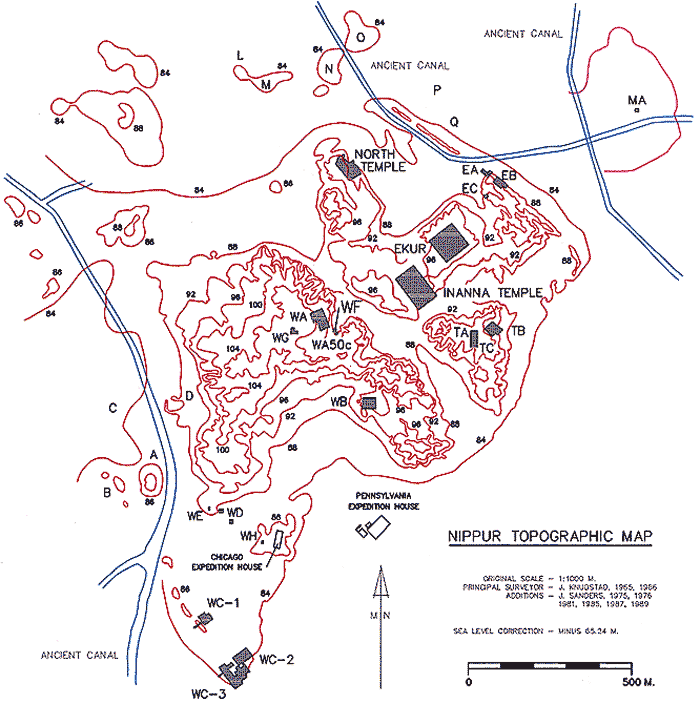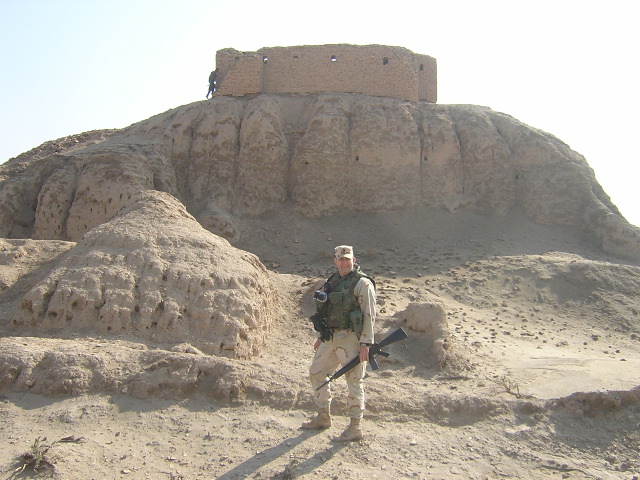It looks like you're using an Ad Blocker.
Please white-list or disable AboveTopSecret.com in your ad-blocking tool.
Thank you.
Some features of ATS will be disabled while you continue to use an ad-blocker.
20
share:
Not many people are aware that the original location of Purgatory, the Divine rehabilitation centre, was on Earth in the Sumerian city of Nippur some
5,000 years ago, in the vicinity of the E-Kur, House of the Great Mountain, the ziggurat of Enlil.
Nungal then a daughter of Anu and Ereškigala Goddess of the Underworld oversaw the Netherworld correction centre, she was married to Birtum a son of Enlil thus having family connection to the E-Kur complex. In the same sense that the ziggurat established connectivity to the Heavens then the dungeons correlated to the Netherworld.

I don't think this netherworld has yet been located in excavations at Nippur, it would have been in the vicinity of the ziggurat but had a descending stairway into the subterranean regions, it was designed to inspire fear, there were motifs of serpents with their tongues out as if tasting the approaching prey...
Within the complex the conditions were as one would expect to find in the Netherworld, the main aim were possible was to reconcile a person with their personal head God, such that the individual could retake their place within society, thus the recidivists and nay sayers once again saw the light of conformity.

In many ways this was a forerunner of the principles of the Roman Catholic inquisition, nobody ever expected the Sumerian inquisition...

The correction centre was seen then as restoring individuals and thus maintaining harmony and cohesion within the greater Sumerian religious system, the overall theme was toward compassion and forgiveness.
The desired end result then being a man returned happily to his God, a sort of Divine Marriage counselling.
Importantly this gives rise to conceptions of rebirth within Sumerian religion, the return from the Underworld of the righteous.
A Hymn to Nungal
The Ekur was seen as a place of judgement and the place from which Enlil's divine laws are issued. The ethics and moral values of the site are extolled in myths. The Ekur was noted for inspiring fear, dread, terror and panic in people, especially amongst the evil and ignorant, the Ekur complex included a primordial dungeon of the netherworld or "house of lament" where the damned were sent after judgement. Nungal is the Sumerian goddess who was given the title "Queen of the Ekur". This house is described as having a "River of ordeal" which leads to the "mouth of catastrophe"
The hymn also references a "house of life" where sinners are rehabilited and returned to their gods through the compassion of Nungal, who holds the "tablet of life"
Nungal then a daughter of Anu and Ereškigala Goddess of the Underworld oversaw the Netherworld correction centre, she was married to Birtum a son of Enlil thus having family connection to the E-Kur complex. In the same sense that the ziggurat established connectivity to the Heavens then the dungeons correlated to the Netherworld.
House, furious storm of heaven and earth, battering its enemies; prison, jail of the gods, august neck-stock of heaven and earth! Its interior is evening light, dusk spreading wide; its awesomeness is frightening. Raging sea which mounts high, no one knows where its rising waves flow. House, a pitfall waiting for the evil one; it makes the wicked tremble! House, a net whose fine meshes are skillfully woven, which gathers up people as its booty! House, which keeps an eye on the just and on evildoers; no one wicked can escape from its grasp. House, river of the ordeal which leaves the just ones alive, and chooses the evil ones! House, with a great name, nether world, mountain where Utu rises; no one can learn its interior!

I don't think this netherworld has yet been located in excavations at Nippur, it would have been in the vicinity of the ziggurat but had a descending stairway into the subterranean regions, it was designed to inspire fear, there were motifs of serpents with their tongues out as if tasting the approaching prey...
House whose foundations are laden with great awesomeness! Its gate is the yellow evening light, exuding radiance. Its stairs are a great open-mouthed dragon, lying in wait for men. Its vault is the rainbow, imbued with terrible awe
Within the complex the conditions were as one would expect to find in the Netherworld, the main aim were possible was to reconcile a person with their personal head God, such that the individual could retake their place within society, thus the recidivists and nay sayers once again saw the light of conformity.
The gods of heaven and earth bow down before its place where judgments are made. Nin-egala takes her seat high on its lapis-lazuli dais. She keeps an eye on the judgments and decisions, distinguishing true and false. Her battle-net of fine mesh is indeed cast over the land for her; the evildoer who does not follow her path will not escape her arm.
When a man of whom his god disapproves arrives at the gate of the great house he is delivered into the august hands of Nungal, the warden of the prison; this man is held by a painful grip like a wild bull with spread forelegs. He is led to a house of sorrow, his face is covered with a cloth, and he goes around naked.

In many ways this was a forerunner of the principles of the Roman Catholic inquisition, nobody ever expected the Sumerian inquisition...
Even a powerful man cannot open up its door; incantations are ineffective . It opens to a city in ruins, whose layout is destroyed. Its inmates, like small birds escaped from the claws of an owl, look to its opening as to the rising of the sun. Brother counts for brother the days of misfortune, but their calculations get utterly confused. A man does not recognise his fellow men; they have become strangers.
The interior of the temple gives rise to weeping, laments and cries. Its brick walls crush evil men and give rebirth to just men. Its angry heart causes one to pass the days in weeping and lamentation. When the time arrives, the prison is made up as for a public festival; the gods are present at the place of interrogation, at the divine river ordeal, to separate the just from the evildoers; a just man is given rebirth. Nungal clamps down on her enemy, so he will not escape her clutches.

The correction centre was seen then as restoring individuals and thus maintaining harmony and cohesion within the greater Sumerian religious system, the overall theme was toward compassion and forgiveness.
My own mother, Ereškigala, has allotted to me her divine powers. I have set up my august dais in the nether world, I am the goddess of the great house, the holy royal residence. I speak with grandeur to Inana, I am her heart's joy.
"Mercy and compassion are mine. I frighten no one. I keep an eye upon the black-headed people: they are under my surveillance. I hold the tablet of life in my hand and I register the just ones on it. The evildoers cannot escape my arm; I learn their deeds. All countries look to me as to their divine mother. I temper severe punishments; I am a compassionate mother. I cool down even the angriest heart, sprinkling it with cool water. I calm down the wounded heart; I snatch men from the jaws of destruction."
The desired end result then being a man returned happily to his God, a sort of Divine Marriage counselling.
"When someone has been brought into the palace of the king and this man is accused of a capital offence, my chief prosecutor, Nindimgul, stretches out his arm in accusation He sentences that person to death, but he will not be killed; he snatches the man from the jaws of destruction and brings him into my house of life and keeps him under guard.
My house gives birth to a just person, but exterminates a false one. Since there are pity and tears within its brick walls, and it is built with compassion, it soothes the heart of that person, and refreshes his spirits."
"When it has appeased the heart of his god for him; when it has polished him clean like silver of good quality, when it has made him shine forth through the dust; when it has cleansed him of dirt, like silver of best quality , he will be entrusted again into the propitious hands of his god. Then may the god of this man praise me appropriately forever! May this man praise me highly; may he proclaim my greatness!
Importantly this gives rise to conceptions of rebirth within Sumerian religion, the return from the Underworld of the righteous.
A Hymn to Nungal
Star and flag. Interesting thread. I've never heard of Ekur before. And here I thought purgatory was in Parsippany, NJ.
a reply to: UnBreakable
A very interesting place, there is suggestion in the texts that the net of Nungal was extended toward all countries, that their inhabitants may well have been carried off to the E-Kur for rehabilitation, and this perhaps explains why it was continually attacked and destroyed, despite being the City of Enil, Lord of Destiny and Fate, a reputation for oppression.
The Curse of Agade
Something else i forgot to mention but which is very important is that Nungal restored through the power of the 7th aura of awesome radiance, in that according to the Gilgamesh myth this had been given to her;
In the Hymn to Nungal;
A very interesting place, there is suggestion in the texts that the net of Nungal was extended toward all countries, that their inhabitants may well have been carried off to the E-Kur for rehabilitation, and this perhaps explains why it was continually attacked and destroyed, despite being the City of Enil, Lord of Destiny and Fate, a reputation for oppression.
The destruction and fall of these various structures is remembered in various city laments, destroyed either in a great storm, flood or by variously Elamites, Subarians, Gutians and some other, as yet unidentified "Su-people". It was also recorded that the terrible acts of final destruction of the Ekur and it's divine laws was committed by Sargon the great against his own people in approximately 2300 BC. The Curse of Agade describes the same thing happening at the hands of Naram-Sin "Enlil, because his beloved Ekur had been attacked, what destruction he wrought".
The Curse of Agade
Something else i forgot to mention but which is very important is that Nungal restored through the power of the 7th aura of awesome radiance, in that according to the Gilgamesh myth this had been given to her;
Enlil then took the powerful auras from Gilgamesh and began distributing their power. The lord of the gods gave Huwawa's first aura to the fields as this would bring fruitfulness to the lands. He gave his second aura to the rivers to feed those fields. The third he gave reed beds and another to the lions to compliment the power they already had. He gave Huwawa's next aura to the forests and hills. He gave another aura to the debt slaves as he was a great lord of wealth and prosperity. This proved him to be great among masters.
Finally, in memory of Huwawa, gave his seventh aura to Nungal, the goddess of prisoners.
In the Hymn to Nungal;
Nungal, its lady, the powerful goddess whose aura covers heaven and earth..
Because the lady has revealed her greatness; because she has provided the prison, the jail, her beloved dwelling, with awesome radiance, praise be to Nungal
edit on Kam731181vAmerica/ChicagoTuesday0131 by Kantzveldt because: (no reason given)
a reply to: Kantzveldt
A place of de-soul-ation and mind control programming. Nothing positive there then, and nothing positive in its modern re-creation.
A place of de-soul-ation and mind control programming. Nothing positive there then, and nothing positive in its modern re-creation.
Reminds me a lot of where I work...I musta been a bad, bad monkey to end up here!
S&F Kantz I have been waiting for this one well done! Celestial Marriage counseling...
S&F Kantz I have been waiting for this one well done! Celestial Marriage counseling...
a reply to: Orphanim
The very opposite of soul negation, Nungal held the power of the 7th aura, ask any mystagogue what that's all about, she was closely related to the healing Goddess Bau who also had a Temple at Nippur, and got along famously with Inanna, who again had a large Temple in the City, this was understood as an essential aspect of mankind maintaining harmonious relationship with the Divine, thus Nungal restored the soul.

a reply to: abeverage
I guess the Roman Catholic church gave this sort of thing a bad name when they re-enacted it 4,000 years later, but that's just because their inquisition wasn't run by Nungal...
The very opposite of soul negation, Nungal held the power of the 7th aura, ask any mystagogue what that's all about, she was closely related to the healing Goddess Bau who also had a Temple at Nippur, and got along famously with Inanna, who again had a large Temple in the City, this was understood as an essential aspect of mankind maintaining harmonious relationship with the Divine, thus Nungal restored the soul.

a reply to: abeverage
I guess the Roman Catholic church gave this sort of thing a bad name when they re-enacted it 4,000 years later, but that's just because their inquisition wasn't run by Nungal...
edit on Kam731181vAmerica/ChicagoTuesday0131 by Kantzveldt because: (no reason given)
originally posted by: UnBreakable
Star and flag. Interesting thread. I've never heard of Ekur before. And here I thought purgatory was in Parsippany, NJ.

a reply to: Kantzveldt
Those murals are insane... Great find!
The Sumerian subject never fails to impress.
Those murals are insane... Great find!
The Sumerian subject never fails to impress.
edit on 1-7-2014 by Aqualung2012 because: (no reason given)
a reply to: BlueMule
I know America has had a long term interest in the original siting of Purgatorio...
Tell Nuffar

Nippur US Military Presence
I know America has had a long term interest in the original siting of Purgatorio...
Nippur, one of the most ancient of all the Babylonian cities of which we have any knowledge (some historians date it back to 5262 BC)
One of the largest sites in Mesopotamia, Nippur covers about 150 hectares, measures over 1-1/2 km across, and rises as much as 20 kilometers above the plain. The site is divided in two by the dried bed of a watercourse. In addition to the Ekur complex, consisting of a ziggurat and temple to Enlil, are other temples, the most important of which is the Inanna/ Ishtar temple. Careful excavations here uncovered more than 20 building levels from the Middle Uruk (4000 BC) – Parthian (220 AD), providing the longest continuous archaeological sequence for Mesopotamia.
Sites Assessment: Nippur has for more than a hundred years been under excavation by an American expedition. Upon last inspection, there was no longer a guard at the site, but the dig house is still there. Since excavations and maintenance of the excavated area were not possible for a long time, the exposed mud brick architecture suffered from erosion. During late spring and summer of 2003, looting of the site destroyed a major part of the Ziggurat and may have occurred in areas other than the Ziqqurrat, such as the "Tablet Mound" (Areas TA / TB)], the outmost Northern tells of the city. At the small mound on the Northern fringe of the tell, about 50 to 100 holes were observed. More illicit holes seen on recent inspection.
Tell Nuffar

Nippur US Military Presence
new topics
-
Judge rules president-elect Donald Trump must be sentenced in 'hush money' trial
US Political Madness: 7 hours ago -
Farmers wife
Music: 8 hours ago -
NJ Drones tied to Tesla explosion at Trump Las vegas
General Conspiracies: 9 hours ago
top topics
-
Matthew Livelsberger said he was being followed by FBI
Political Conspiracies: 15 hours ago, 16 flags -
How the Sikhs Deal with Muslim Grooming Gangs – Tommy Robinson
Social Issues and Civil Unrest: 17 hours ago, 8 flags -
New Jersey-Teachers Can Now Be Certified Without Passing Basic Reading Writing Math Testing
Education and Media: 13 hours ago, 8 flags -
NJ Drones tied to Tesla explosion at Trump Las vegas
General Conspiracies: 9 hours ago, 6 flags -
Judge rules president-elect Donald Trump must be sentenced in 'hush money' trial
US Political Madness: 7 hours ago, 2 flags -
Farmers wife
Music: 8 hours ago, 1 flags
active topics
-
Tesla Cybertruck Explodes in Front of Trump Hotel in Las Vegas
Mainstream News • 201 • : Flyingclaydisk -
Vehicle Strikes people in New Orleans
Mainstream News • 291 • : ADVISOR -
Musk calls on King Charles III to dissolve Parliament over Oldham sex grooming gangs
Mainstream News • 92 • : andy06shake -
NJ Drones tied to Tesla explosion at Trump Las vegas
General Conspiracies • 9 • : Flyingclaydisk -
Petition Calling for General Election at 564,016 and rising Fast
Political Issues • 210 • : BedevereTheWise -
The Why Files Lacerta Reveals the Truth of our Creation
Aliens and UFOs • 10 • : YouSir -
Here we again... CHINA having mass outbreak of something
Diseases and Pandemics • 19 • : angelchemuel -
FIEND SLASHED: Sara Sharif’s killer dad ‘has neck & face sliced open with jagged tuna tin lid
Mainstream News • 20 • : Lazy88 -
UK Borders are NOT Secure!
Social Issues and Civil Unrest • 22 • : angelchemuel -
Grenfell Tower Fire revisited
Mainstream News • 9 • : angelchemuel
20

